The saunas on the site can be small for family use or large for lovers of steam in a noisy company. The choice of material remains unchanged. Standard buildings made of rounded logs are replaced by buildings with walls made of glue or profiled beams, expanded clay blocks, bricks, and aerated concrete. They take into account the conditions on the site, the layout of the bath, its dimensions.
General requirements for materials for building a bath
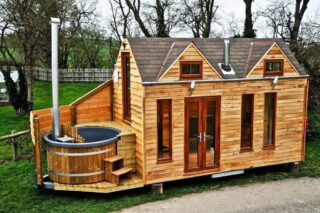
Sauna materials directly affect the durability of operation. The microclimate and indoor comfort depends on the quality and environmental friendliness of building materials.
Requirements for materials for construction:
- high thermal insulation characteristics;
- moisture resistance;
- strength, reliability.
Baths are often heated with wood, so temperature differences are observed inside. A change from a hot, humid climate to a cold one should not destroy the outer walls and interior decoration of the room. Sometimes they use a combined method of erecting walls, when a log house is made, then they cover it with blocks or bricks.
Material selection criteria
Modern technologies make it possible to build any type of building with the required characteristics of humidity and temperature conditions. An important part when choosing is the financial component of the future building.
Other criteria:
- The appearance of the building should be in harmony with the general landscape of the site and the residential building. Chopped walls do not look right next to a high-tech building, and a marble steam room does not fit a stylized log hut.
- The location of the bath on the site. It can be built separately or adjacent to the house with one wall.
You cannot rely only on aesthetic appeal, you need to remember about the technical characteristics of building materials.
It is important to consider the quality of the purchased materials. If the building is large and the owner wants to save money, it is better to choose a different cost reduction method. They reduce the size of the building, make the steam room smaller, remove the terrace and other additional rooms.
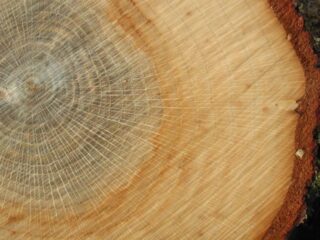
Popular building materials:
- wooden lumber, timber, boards;
- expanded clay concrete blocks;
- red ceramic brick;
- aerated concrete or foam concrete blocks;
- a natural stone;
- metal or wooden frame with lining.
Before starting construction, the properties are studied, since they differ for each material.
Wood for building a bath
The low thermal conductivity of wood helps to create a comfortable indoor climate. Thanks to their good protection from the cold, such walls save fuel consumption. Wood belongs to the group of environmentally friendly materials, has a high resistance to static forces and dynamics.
When loaded along the fibers, some rocks are not inferior to the strength of concrete, and when working in bending, they even surpass it. The tree is easy to process, glue, connect with a tie-in. Nails and staples are easily hammered into the walls. Modern processing methods extend the operating time.
Wood allows steam to pass through, therefore it is able to regulate the humidity inside, it picks up excess moisture and gives it away when the air dries.
For construction, dried wood is used, the moisture content of which does not exceed 18%. Lumber can be unbeamed and faceted. The second type involves cutting along the length of the trunk. The result is edged, non-edged and planed boards.
To make a bath, lumber is used:
- edged, planed timber;
- planed board;
- rounded logs, planed, carriage, barked.
For exterior and interior decoration, they take lining, block house, euro-board from wood residues. The appearance and performance of the structure depends on the choice of the type of wall material.
Pine
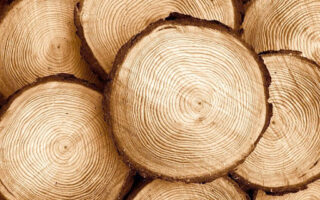
The breed has a pinkish tint. Wood resists rotting, but is susceptible to fungal damage. It does not delaminate and split very well, while there are many resin inclusions inside. A popular type for the construction of baths and saunas.
Imported materials are represented in construction by yellow pine, which is brought in from Canada. Strong wood contains a lot of resin. Another variety - radiant pine - has the smell of bitumen, is not welcome for decoration inside the steam room.
All pine species are soft and have an attractive grain pattern. The tree is poorly painted and pickled due to resinous components, therefore, it is cleaned with various solvents before work.
Aspen
Easily processed with hand tools, polished, withstands fastening on nails, screws. The rock does not warp, does not delaminate during operation. Wood does not conduct heat, therefore, you cannot burn yourself against the aspen elements during interior decoration.
It tolerates changes in temperature and humidity well. It is capable of being saturated with moisture, which it easily gives off when ventilated. After drying, it does not shrink, does not change geometry. Aspen contains substances that kill mold and microorganisms, it resists rotting well. Over time, unpleasant odors do not appear. The bitter, pleasant aroma has a positive effect on health.
Larch
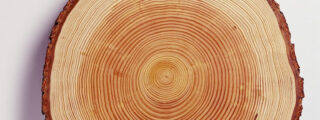
The core of the trunk is visible on the cut, so the wood is distinguished by rich colors. The logs have a thick bark, many knots and resinous passages. Baths are made from Siberian larch, the breed has increased hardness and strength.
The material resists shock, does not collapse from friction, and wears out for a long time. Belongs to a hardly flammable category. In a humid environment, it does not lose quality and shape due to the large volume in the composition of natural resin and tanning components.
Fungus does not appear on the surface, blue and black mold spots, this property is due to the high concentration of gum, so the breed is suitable for making walls in a bath. Thermal conductivity is low, heat remains in the room for a long time, while the released phytoncides have a positive effect on health.
Linden
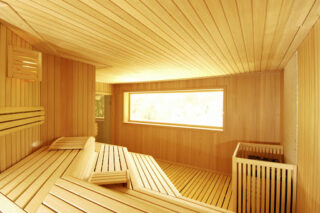
Wood has a low density, so it resists sudden changes in temperature well. The material is easily sawn, sanded by hand, so it is better to make a bath of this material. The breed is prized for its health benefits. The wood does not deform under the influence of outdoor factors, therefore, the number of maintenance and repairs is reduced.
Linden is classified as a honey plant, the wood of which does not emit a lot of resin, so there are no problems with installing the material in the steam room. The exterior is attractive, the outer walls will look dignified in the ensemble of the courtyard landscape.
The tree has an average cost, it is common in the building materials market, therefore it is popular among owners of summer cottages.
Alder
The breed belongs to the birch family. There are almost 30 varieties of trees in the category, which is why bushes and trunks are called alder. The dense structure is characterized by thin fibers, and the rings have a blurred pattern.For the construction of the bath, black alder is used.
Wood conducts heat poorly, does not overheat, and is characterized by low hygroscopicity. Alder does not absorb water, so it retains its shape and geometry in the cold. Lumber almost does not rot, there are antibacterial components inside the tree.
The material does not interfere with air exchange, allows vapors to pass through, so condensation and moisture do not accumulate on the walls.
Fir
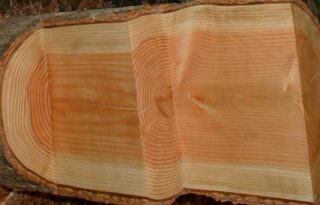
They belong to expensive materials, therefore they are relatively rarely used in the construction business. Fir wooden buildings are resistant to shrinkage, cracking, and mold. The material releases useful phytoncides into the atmosphere, the process is activated when heated.
The breed has no smell, which distinguishes it from cedar and pine, since not all people love the woody spirit. Being in a fir bath is good for your health, since there is no resin in the wood, it will not be released when the temperature rises.
The disadvantage of fir is its low resistance to moisture, which can cause lumber to rot. Before construction, they are treated with special impregnations.
Erection from a bar
Profiled timber allows you to make a wide variety of bath buildings, practical material is used for mobile buildings and large complexes with pools and terraces. The beam shrinks a little after erection, since a special technology is used in production.
Timber construction is fast, especially if professionals are involved. The walls have a presentable look, the building looks neat and modern. If you choose a good quality timber, you can skip the finishing.
The material is characterized by low thermal conductivity, and the connection "warm corner" and groove-ridge increases the protective properties.
Other materials
Expanded clay concrete
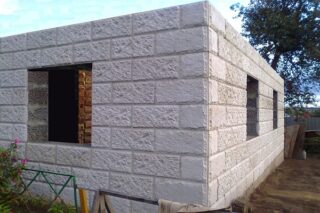
Concrete blocks with lightweight aggregate are large, so the masonry goes faster, mortar is saved by reducing the length of the joints. Large expanded clay concrete blocks are lightweight, so there is no need to build a massive foundation. There is no need to order a crane for construction.
For masonry, a special ready-made composition is used or blocks are placed on a cement-sand mortar. The low cost of the material makes it popular for the construction of bath walls. When choosing, take into account the correctness and accuracy of cutting stones, since uneven seams increase the volume of the solution used.
Brick
Walls will last a long time compared to wood, without the need for regular surface repairs. The brick does not need protection from the aggressive outdoor environment. The material does not burn in case of fire, belongs to the category of environmentally friendly wall materials.
Small-sized elements provide a great opportunity for the choice of architectural forms. The surface can be finished with various materials, but the front masonry looks beautiful even without cladding. The material is highly durable, does not react to high humidity.
The disadvantages include slow construction, high cost of purchasing material. A deep foundation is made under the walls, designed for the increased weight of brick fences.
Aerated concrete and foam concrete
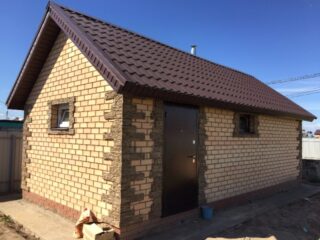
The stones are characterized by a porous structure that reduces heat transfer. Foam blocks have closed pores inside, therefore they do not absorb moisture, and aerated concrete is distinguished by internal connected passages through which moisture enters the blocks. The first type does not require waterproofing, and the gas blocks must be protected from water.
Foam concrete and aerated concrete are based on the same raw materials, belong to the environmentally friendly category. The blocks are ideally shaped, so little mortar or special glue is used for the masonry. The masonry is reinforced in the first row, and metal rods are placed every 3 to 4 rows in height.To support the roof beams, a reinforced concrete belt is constructed around the perimeter of the wall.
A rock
The stone walls are strong, do not burn, do not rot and stand for a long time. In the event of a fire, the finish burns out, but the skeleton remains intact. Refers to universally available, but expensive building materials. Masonry technology requires a certain skill and skill.
For thick and heavy walls, a massive strip foundation is built. Natural material is not harmful to health, but it does not allow steam and air to pass through, therefore condensation drops often appear on the surface. Stone walls cool down quickly, so they are thermally insulated. The stone is not destroyed by microorganisms, which is why it is not pretreated with antiseptics.
Construction of frame baths
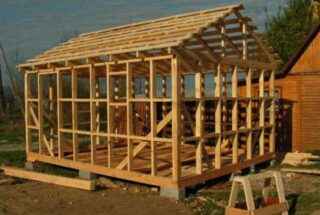
Prefabricated structures have a lot of advantages, the walls do not shrink over time. The frame material is wood or metal. For stitching, boards, boards, sheets of OSB with wax impregnation are used. The reliable design lasts a long time and does not deform over time.
Frame structures can be finished from the outside with different materials, external insulation can be used. The disadvantage is the negative perception of high humidity, therefore, wooden posts, crossbars, struts are processed before installation.
The structure of the frame wall contains insulation, lining inside and outside, a vapor barrier, waterproofing and windproof layer.
Bath thermal insulation
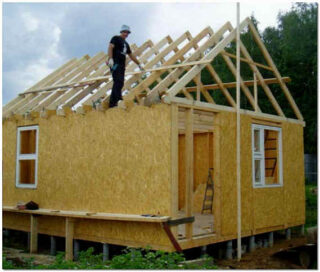
Wooden walls are insulated from the outside with caulking cracks, for which they use tow, jute. If a frame finish is provided, a foam, mineral wool insulation is inserted between the elements. Mineral wool requires a counter grid to create a ventilated space for ventilation from condensation. Requires insulation and the foundation of the structure.
The walls, floor and ceiling are insulated inside. In the construction of the floor, a rough gap is provided, where the insulation is laid. To protect the walls from the inside, a frame is made, slag wool, stone wool, cellulose are used.
The ceiling is insulated from the inside, while it is hemmed with boards. If the insulation is installed from the side of the attic gap, extruded polystyrene foam, polystyrene foam, polyurethane foam are used.








